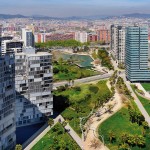
Barcelona, like other European cities, is subject to intense gentrification pressures in some of its most emblematic neighbourhoods. In this dossier, with the help of leading specialists in urban issues, we review the particularities of this phenomenon.

Neoliberal policies have transformed traditional urban spaces for socialising, which have been taken over by mercantilism. Gentrification, far from being neutral, is in fact a process that is defined in terms of class and therefore of conflict.

To prevent residents being driven out of their neighbourhoods, Barcelona must follow three courses of action: civilise the property market, build up public housing stock with a well-balanced geographic distribution and turn to social co-production of mixed residential solutions.

Here we describe the experiences, new or established over time, of eight cities that are standing up to the phenomenon of gentrification.

() Diversos municipis que han emprès iniciatives de creació d’espais verds han generat noves desigualtats o han exacerbat les que ja existien. Com abordar els efectes indesitjables i inequitatius de l’urbanisme verd?

Gentrified neighbourhoods are an object of desire for many tourists and, at the same time, the presence of tourism reinforces gentrification processes. Far from being a seasonal phenomenon located in specific spaces, tourism competes for resources with the other citizens, leading to the displacement of the resident population.

Women in particular suffer the real-estate violence generated by gentrification. Public regulation of the property market ought to incorporate gender as an indicator of vulnerability. At the same time, labour legislation should be changed to protect reproductive and care work.

La Ribera, Gràcia, Poble-sec, Sant Antoni and the area around the Rambla del Poblenou are the most gentrified areas in Barcelona, according to the results of a pioneering study that will help develop preventive policies.

There are laws guaranteeing access to housing as an essential right over any other right and that give the public administration ample means to intervene in its defence.

Thanks to municipal leadership and the work of neighbourhood representatives, the regeneration of Ciutat Vella, which got under way in 1980, has successfully tackled the problem of urban desertification that has affected other European city centres.












